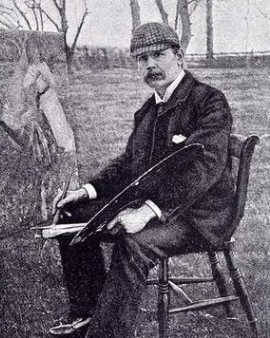English naturalism has produced its most famous and significant painters since the middle of the 19th century. Especially in relation to England, this art epoch remains so interesting because the painters assigned to it painted on a millennium threshold. One of these threshold painters was Henry Herbert La Thangue. His path and biography are characteristic of many British painters of his generation: these artists rediscover nature, rural light and village life as a genre motif once again, precisely at a time when, due to industrialisation, so-called simple country life in its classical form was changing dramatically, if not, in the course of industrialisation, disintegrating here and there. From the Frenchman Paul Cézanne, who, born a little earlier, went his own way as a painter, while preparing for Impressionism, the saying is passed down: "You have to hurry so that you can still see something.
This saying also describes in an exemplary way the mood and the basic feeling of the English naturalists and one of his great representatives Henry Herbert La Thangue. The farewell to old slowness, the running into the era of mobility, into the new and increasing urbanisation and industrialisation, which was so unusual for those times, led to a sudden compulsion for many painters to look back into the open, unspoilt nature, which, however, cannot be satisfied with the slightly pejorative sounding word idylllic in the sense of the cosy and Biedermeier. All these painters were too restless, too searching, too reflective for that, and above all: too interested in the developments of their time, including photography and its new and clear way of depicting the world.
Henry Herbert La Thangue was born in 1859, exactly at a time when England's first industrial revolution of technology, including steam engines, railways and factories, had brought about its great flowering of development, with all the new upheavals and social and scenic changes and upheavals that accompanied this revolution. Painterly highly talented, he soon belonged to the elite of English painters, albeit often in opposition to the established Royal Academie, to which a competing "New English Art Club" had been founded, in whose environment he became an influential personality.
In 1890, at the age of 31, Henry Herbert La Thangue completed a painting entitled "Leaving Home". It shows a peasant woman crying because she now has to move to the city to serve. When one considers that it is handed down how such a motif with a socio-critical and time-commentary intention triggered "controversies" at the time, one can imagine how much in England at the end of the 19th century the painters and naturalists were by no means mere idyllists, but rather contemporaries who were critically and alertly interested in their present.
Henry Herbert La Thangue, who had also spent a long time in France and the last years of his life in rural Italy, died in 1929 where he was born - in the great city of London.
×





.jpg)
.jpg)
.jpg)
.jpg)
_-_(MeisterDrucke-551700).jpg)
_-_(MeisterDrucke-551700).jpg)
.jpg)
.jpg)
.jpg)
.jpg)
_-_(MeisterDrucke-1315491).jpg)
_-_(MeisterDrucke-1315491).jpg)
.jpg)
.jpg)
_-_(MeisterDrucke-1127183).jpg)
_-_(MeisterDrucke-1127183).jpg)
.jpg)
.jpg)
.jpg)
.jpg)
_-_(MeisterDrucke-1515351).jpg)
_-_(MeisterDrucke-1515351).jpg)
.jpg)
.jpg)
.jpg)
.jpg)
.jpg)
.jpg)
.jpg)
.jpg)
.jpg)
.jpg)
.jpg)
.jpg)
.jpg)
.jpg)
.jpg)
.jpg)
.jpg)
.jpg)
.jpg)
.jpg)
.jpg)
.jpg)
.jpg)
.jpg)
.jpg)
.jpg)
.jpg)
.jpg)
.jpg)
.jpg)
_-_(MeisterDrucke-1173108).jpg)
_-_(MeisterDrucke-1173108).jpg)
.jpg)
.jpg)
_-_(MeisterDrucke-1127182).jpg)
_-_(MeisterDrucke-1127182).jpg)
.jpg)
.jpg)
.jpg)
.jpg)
.jpg)
.jpg)
.jpg)
.jpg)
.jpg)
.jpg)
.jpg)
.jpg)
_-_(MeisterDrucke-1128973).jpg)
_-_(MeisterDrucke-1128973).jpg)
_-_(MeisterDrucke-1131411).jpg)
_-_(MeisterDrucke-1131411).jpg)
.jpg)
.jpg)
.jpg)
.jpg)
_-_(MeisterDrucke-1118852).jpg)
_-_(MeisterDrucke-1118852).jpg)
.jpg)
.jpg)
.jpg)
.jpg)
.jpg)
.jpg)
.jpg)
.jpg)
_-_(MeisterDrucke-1520298).jpg)
_-_(MeisterDrucke-1520298).jpg)
.jpg)
.jpg)
.jpg)
.jpg)
.jpg)
.jpg)
.jpg)
.jpg)
_-_(MeisterDrucke-1131137).jpg)
_-_(MeisterDrucke-1131137).jpg)
.jpg)
.jpg)
.jpg)
.jpg)
.jpg)
.jpg)
_-_(MeisterDrucke-1127181).jpg)
_-_(MeisterDrucke-1127181).jpg)
.jpg)
.jpg)
.jpg)
.jpg)
.jpg)
.jpg)
.jpg)
.jpg)
.jpg)
.jpg)
.jpg)
.jpg)
_-_(MeisterDrucke-1113181).jpg)
_-_(MeisterDrucke-1113181).jpg)
.jpg)
.jpg)
.jpg)
.jpg)
.jpg)
.jpg)
.jpg)
.jpg)
.jpg)
.jpg)
.jpg)
.jpg)
.jpg)
.jpg)
.jpg)
.jpg)






